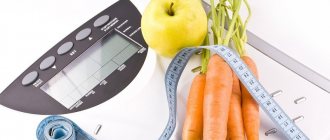At any time of the year you want to look slim, especially in summer. Women try to lose excess weight, but this does not always work. It's all about an illiterate diet. This article discusses in detail the healthy nutrition menu for a week for every day. It will help you adjust your diet and speed up the weight loss process.
Let's get acquainted with the term “ healthy food ”, which has been talked about so much lately. It means eating balanced components throughout your life. There must be a calculated exact amount of FBU (fats, proteins and carbohydrates) for each day. In such proportions, food becomes healthy, helps get rid of obesity of any degree, strengthens the immune system and prolongs youth.
Before you create a proper nutrition menu for a week for weight loss, you need to find out which foods you should eat and which you should avoid.
Calorie intake per day
As such, there is no single and generally accepted daily calorie intake. According to the recommendations of the World Health Organization, “energy entering the body (in calories) must be balanced with energy expended.” Thus, your individual calorie intake depends, first of all, on the nature of your work, level of physical activity, gender, age and a number of other factors. However, on the Internet you can find many tables and calculators of unknown origin, offering information on daily values, supposedly based on authoritative sources. We believe that the quality of this information is quite questionable.
The most reliable way to determine individual calorie needs is to simply calculate the energy value of food consumed during the day (or several days). Just record your normal daily diet on paper. Write down what and how much you ate during the day. Calorie content can be directly calculated using information from product labels and using our website. Provided that you are healthy and your weight does not change much with your current diet, the results obtained can be conditionally considered your daily norm.
To lose weight, you need to slightly reduce your daily energy intake. If you maintain your current lifestyle, you will experience a slight calorie deficit because your costs will remain the same. This will lead to the gradual burning of your fat reserves. What exactly the deficit should be is up to you to decide. We strongly advise against increasing it sharply, because... it won't lead to anything good. Reduce your calorie intake gradually and lose weight slowly. This way you won’t have to torture yourself and break down from time to time. And of course, before making any dietary changes, we strongly recommend that you consult with your doctor or qualified dietitian.
Delicious diet menu: basic principles of dietary nutrition
It doesn’t matter at all whether you decide to lose weight in one week or want to instill healthy habits in yourself to become stronger and more energetic. There are several rules that reflect the principles of proper nutrition that should be taken into account.
- Vegetables and fruits should be consumed daily to maintain the balance of vitamins in the body.
- You cannot completely give up dairy products (we are talking about natural products, without sugar and fruit additives).
- The weekly menu must include fish as an essential source of omega-3 acids.
- Animal fats must be replaced with vegetable fats.
- Plan your menu for each week. It is easier and more profitable to buy groceries once every 7 days than to go to the store every day and expose yourself to unnecessary temptations.
- The daily diet includes 5 meals: breakfast, snack, lunch, snack, dinner.
- Monitor not only the foods you eat, but also the amount of liquid you drink. Try to drink as much water as possible. Avoid packaged juices and carbonated drinks. You can also drink green tea with honey or coffee with minimal sugar.
Should the menu be different for weekdays and weekends? Nutritionist Lidia Ionova believes so, and explains how to create a dietary menu for every day based on food groups.
Menu for weight loss
Menu for weight loss - this topic is relevant for many women who want to lose weight. Who doesn't want to look good and have a slim figure?
You don't have to go on an expensive diet to do this. To be slim, just follow simple rules:
- Eat at the same time every day. Have breakfast before 9 am, lunch before 2, dinner before 7. This will improve metabolism;
- You need to eat right. The feeling of fullness occurs 20 minutes after eating. Therefore, you need to leave the table feeling a slight feeling of hunger. Food must be chewed thoroughly;
- Don't snack on sweets. Better eat an apple or a piece of dark chocolate.
The cheapest diet is a water diet, but it is not suitable for everyone.
There are many options for inexpensive diets for weight loss. They give preference to seasonal vegetables and fruits, cereals and lean meats.
How to calculate portion sizes when eating healthy?
Most of us don’t think about such little things, but simple comparisons show that “standard portions” of some common foods are becoming larger every year. A simple example: in the 1990s, a regular bun weighed 40 g, now it weighs 55.
Experts have started calculating portion sizes for proper nutrition so that you can eat different foods without gaining weight.
Actual vs Recommended Portions
We buy many products in packages and naively believe that one jar of yogurt or smoothie, one bag of juice or nuts is one serving. In reality, everything is far from so simple. For example, the recommended serving of yogurt is 150–200 g, while on store shelves you will find many packages of 250 or 300 g. Not to mention large “family” packages, which are usually cheaper per kilogram of product, but in this case, not everyone is able to correctly assess the volume of a portion.
Which? - a British organization, which, like Roskachestvo, is a member of the International Assembly of Consumer Test Organizations, recently conducted an experiment to calculate how much cereal the British eat for breakfast. Experts compared the portions that manufacturers recommend on the packaging and the actual portions that the experiment participants ate for breakfast. It turned out that actual portions exceeded the recommended ones by an average of 63%.
If you carefully study product labels, you can find other interesting details. For example, a small chocolate bar weighing 45 g is considered one serving. But if you buy a large, 200-gram bar of the same brand, the packaging will say that it contains eight servings, so one serving will be only 25 g.
Another example: Coca-Cola comes in 150, 250 and 330 ml packs, all of which count as one serving. But the difference in volumes is very significant!
We eat more than we need
These inconsistencies prompted Which? don't stop at breakfast cereals and conduct a large-scale study in June 2021, which involved 1,239 people. All volunteers were asked what serving sizes they thought were recommended for several popular foods.
The results showed that we often overestimate portion sizes and, as a result, eat more than we need and, consequently, gain weight. For example, the recommended serving size for chips in a tube is 30g (as indicated on the package) - this is approximately 14 pieces, but 28% of respondents said that they eat more than a quarter of the package (50g), and some admitted that they are able to finish it in one sitting the whole jar. Explanation: If you leave the chips in an open jar, “they don’t taste as good,” so it’s better to eat them right away and get the most out of them.
A standard frozen pizza sold in supermarkets weighs 300-350g, which many consider to be one serving, but in fact this pizza is intended for two. In addition, most participants believed that the recommended serving of cookies is 4-5 cookies (actually 2), and a bag of popular Smarties candies is intended for one (actually two).
How to calculate the KBZHU so as not to gain weight remotely - HERE
.
How to calculate the amount of food per average serving?
Anna Ivashkevich
nutritionist, clinical psychologist-dietitian, member of the National Association of Clinical Nutrition
“It’s true that portions are getting larger these days, and people are overeating.” It is most difficult to stop in time when you eat salty, sweet, starchy foods or foods with flavor enhancers - primarily processed foods and fast food. How to calculate the correct serving size? It all depends on your goal. Do you want to lose weight, maintain it, or, conversely, gain it? In cases where it is necessary to lose or increase weight, it is wiser to start by consulting a professional nutritionist who will help you adjust your diet. If you want to maintain weight, then follow these rules:
- If we talk about energy value, then the distribution of calories among meals should be as follows: each meal, 40% of calories should come from carbohydrates, 30% from proteins and 30% from fats.
- The optimal composition of the main meal is 150 g of proteins + 200 g of carbohydrates + fats. What fats do I recommend? You can choose one thing from this list: 1 tbsp. l. olive oil, 1 g butter, ½ avocado or 50 g cheese.
Portions for men may be slightly larger than for women, and here you should focus on calorie counting. With average physical activity, a woman needs 1800–2000 calories per day, a man – 2000–2200.
Your optimal portion, in grams:
- Meat – 150–200
- Poultry – 150–200
- Fish and seafood – 200–300
- Dry paste – 60–100
- Dry cereals – 60–100
- Pizza – 2–3 pieces 150 each
- Dumplings – 250–300
- Soups – 300
- Potatoes – 200–300
- Cottage cheese – 100–200
- Yoghurts – 150–200 (1 glass)
- Vegetables – 300
- Fruits – 150–300
- Nuts – 20–30
- Sweets (it’s better not to eat them at all, but this is in an ideal world) – 1 cake / piece of cake / bun 80
How to evaluate portions in a restaurant?
Portions in restaurants, cafes and other establishments are usually larger than what we prepare for ourselves at home. For example, a standard serving of cola in fast food restaurants is usually 400 ml, and the largest is 1123 ml, which is much larger than the standard serving size of 250 ml. A chocolate muffin from a coffee shop weighs about 110 g, and from a supermarket - 75 g. The volume of standard coffee is 300-350 ml, and a large cup can be up to 500 ml. And if the drink is prepared with milk and syrup, then its energy value can reach 350 kcal - a real dessert! Servings of salad, soup or pasta in many restaurants exceed what we would eat at home. All this contributes to an increase in home portions, since those who often eat in cafes and restaurants get used to large volumes.
“In a restaurant, always evaluate dishes by the amount of fat - by adding butter and sauces, the calorie content can increase significantly,” explains Anna Ivashkevich
. – Look at the menu for the grams of the dish, and if you carefully watch your figure, you can ask for a map of dishes by calorie content and composition. Every restaurant has it.
Thank you for reading this text to the end.
Follow the news, subscribe
mail.
When quoting this material, active link to the source
required.
Harrison-Benedict formula calorie calculation
The formula was developed by the American physiologist Francis Gano Benedict and botanist James Arthur Harris at the beginning of the last century, but still remains relevant. Has an error of about 5%.
The formula for calculating the PBM is as follows:
- For women: 655.1 + (9.563 × weight in kg) + (1.85 × height in cm) - (4.676 × age in years);
- For men: 66.5 + (13.75 × weight in kg) + (5.003 × height in cm) - (6.775 × age in years).
The result obtained is the daily calorie intake required by the body for normal functioning. To calculate how many kcal you need to consume to maintain weight, you need to multiply the resulting figure by the physical activity coefficient:
- 1.2 – minimal (sedentary work, lack of physical activity);
- 1.375 – low (training for at least 20 minutes 1-3 times a week);
- 1.55 – moderate (workouts 30-60 minutes 3-4 times a week);
- 1.7 – high (workouts 30-60 minutes 5-7 times a week; heavy physical work);
- 1.9 – extreme (several intense workouts a day 6-7 times a week; very labor-intensive work).











